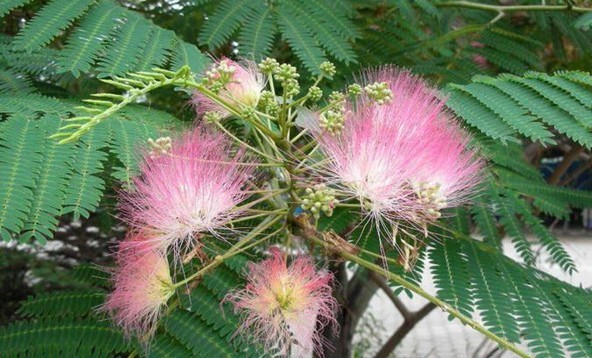Albizia julibrissin is a species of legume in the genus Albizia, native to southwestern and eastern Asia, from Persia east to China and Korea. It is also widely known as Persian silk tree.
The genus is named after the Italian nobleman Filippo degli Albizzi, belonging to the famous Florentine family Albizzi, who introduced it to Europe in the mid-18th century, and it is sometimes incorrectly spelled Albizzia.
Albizia julibrissin is a small deciduous tree growing to 5–12 m tall, with a broad crown of level or arching branches. The bark is dark greenish grey in colour and striped vertically as it gets older. The leaves are bipinnate, 20–45 cm long and 12–25 cm broad, divided into 6–12 pairs of pinnae, each with 20–30 pairs of leaflets; the leaflets are oblong, 1–1.5 cm long and 2–4 mm broad. The flowers are produced throughout the summer in dense inflorescences, the individual flowers with no petals but a tight cluster of stamens 2–3 cm long.
| Catalog | Product Name | CAS Number | Manual |
|---|---|---|---|
| CFN99504 | (-)-Syringaresinol 4-(2''-apiosylglucoside) | 136997-64-3 | |
| CFN98812 | Echinocystic acid | 510-30-5 | |
| CFN98243 | alpha-Spinasterone | 23455-44-9 | |
| CFN96266 | Eudesmin | 526-06-7 | n/a |
| CFN98710 | Betulin | 473-98-3 | |
| CFN98781 | Epicatechin | 490-46-0 | |
| CFN98271 | (-)-Epiafzelechin | 24808-04-6 | |
| CFN98935 | beta-Amyrin | 559-70-6 | |
| CFN97256 | 1H-Indole-3-carboxylic acid | 771-50-6 | n/a |
| CFN98713 | Daucosterol | 474-58-8 | |
| CFN99630 | Phytol | 150-86-7 | |
| CFN99716 | Palmitic acid | 57-10-3 |
A unique collection of 69 natural compounds from Morus alba L.
A unique collection of 25 natural compounds from Glehnia littoralis
A unique collection of 25 natural compounds from Epimedium brevicornum Maxim
A unique collection of 36 natural compounds from Schisandra chinensis (Turcz.) Baill.
A unique collection of 21 natural compounds from Coptis chinensis Franch.





